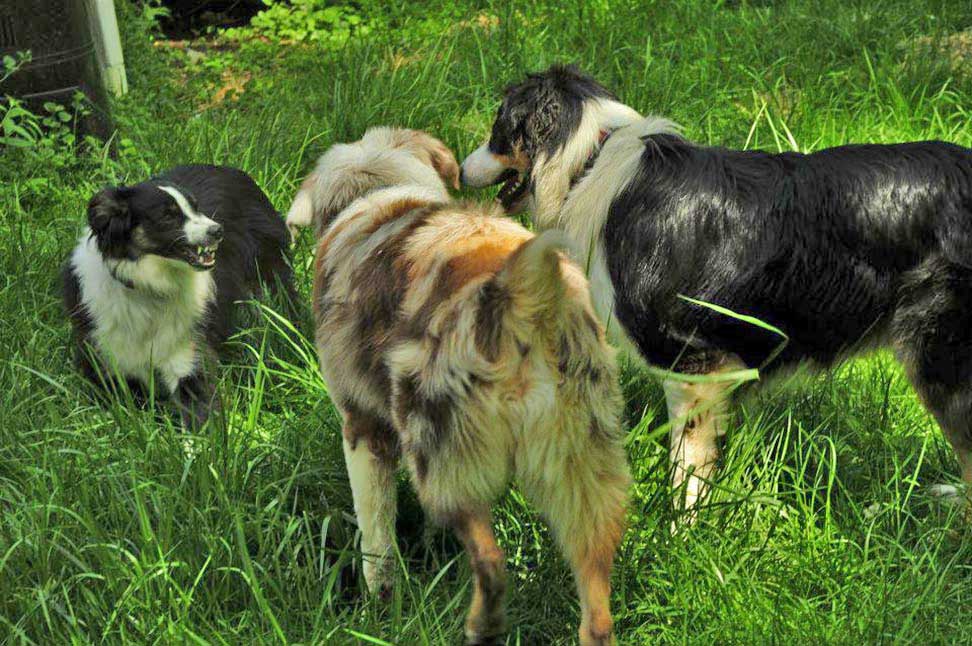On Demand: Offering Manners vs. a Militant Nothing-in-Life-is-Free Program (NILIF)
I recently had a misguided person try to post a comment to one of my blogs that was not actually about the blog’s subject so I chose not to approve it. But aside from not responding to the subject matter at hand, the comment was urging some old fashioned training advice. In the commenter’s words, she was urging a “militant Nothing in Life is Free” approach, in order to keep peace among multiple males.

Jennifer Bird of Furkid Rescue enjoys a partnership with her crew. Photo by Caleb Green.
For those of you who are not familiar with this “program”, it used to be used by lots of dog trainers, positive and balanced alike. It involves commanding dogs to provide some behavior before receiving any kind of resource, be it dinner or affection. The initial goal was to convey the human’s higher status. These days, when the program is suggested by most modern trainers, it is used much differently than in the past.
Why? Because we now know more about dogs and hierarchy and dog behavior in general, especially how they learn best. Commanding has evolved into cueing and among the best trainers and dog parents, much behavior is taught to be offered rather than demanded. Teaching dogs to make better choices and offer the appropriate behavior in many situations not only makes for less work on the owner’s part, it makes for a more polite dog overall.
Rather than demand a sit for dinner, dogs learn to offer it as a matter of routine. The same applies to other high value resources such as passing through doorways, when receiving treats and chew bones, etc. Raised surfaces are another area where manners may need apply but unless a dog is guarding surfaces on a regular basis, my dogs need not ask permission before climbing onto the couch. Militant NILIF users believe differently. The same applies to affection. Now that is not something I am going to expect a sit or something else in order to offer. I share my life dogs because I love dogs and I want to show affection to them and have them do the same without some self entitled gratuitous offering of them bowing down in some way to have that happen.
Of course if a dog is overwhelming in the way that they offer affection to their humans, impulse control gets trained in every situation, including this. But there is no demanding going on. It’s all about teaching a dog to self moderate his or her behavior in order to get what he or she wants.
This person was very focused on an extremely structured approach that bordered on military style, including the wording used. Dogs are social creatures. They thrive in a family atmosphere. Teach them what the boundaries are in a benevolent manner and most will gladly aim to please when rewarded for doing so. Sentient behavior 101. There is no need to run your canine crew like a bunch of military recruits. That is not how you build trust; that is actually a good way to erode it!
Make no mistake, I expect manners in my home and that is what I teach my clients to expect, as well, from their own crews. But as previously noted, there is no need to demand anything. Reward what you want and you get more of it. This is not the place to explain in depth how capturing, shaping and other positive reinforcement methods are done properly. There are other excellent sources for such information. My goal here is to dispel the myth that one needs to be worried about petting one’s dog without demanding said dog perform feats first.
I have fostered many dogs and the first thing I teach them is impulse control. This is taught with a combination of capturing and management. I don’t issue orders. As another trainer recently stated in a well written article about commands versus cues, my dogs don’t have to sit, they get to sit. They LOVE to sit and I rarely have to ask and when I do, it’s with body language and hand signals, not demands. Benevolence is your word for the day, dear readers. Lead by example, not with an iron fist.
For more on this subject, I suggest Kathy Sdao’s wonderful book, Plenty in Life is Free.
Posted in: Projects
Leave a Comment (3) →



 Now those of you who have never had the opportunity or the right circumstances to see such an issue for yourself may wonder what this consists of. The manifestation can vary according to the dog. I have a former class student who’s neutered male screams and stands on his back feet when he gets the close by scent of an intact male. This happened once with a dog in class owned by a friend, who I knew had just been neutered so we assumed that the surgery was simply too fresh. I later learned that said dog had a cryptorchid testicle so the hormones had not fully been removed. The reacting dog had been right!
Now those of you who have never had the opportunity or the right circumstances to see such an issue for yourself may wonder what this consists of. The manifestation can vary according to the dog. I have a former class student who’s neutered male screams and stands on his back feet when he gets the close by scent of an intact male. This happened once with a dog in class owned by a friend, who I knew had just been neutered so we assumed that the surgery was simply too fresh. I later learned that said dog had a cryptorchid testicle so the hormones had not fully been removed. The reacting dog had been right!












